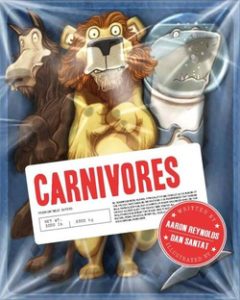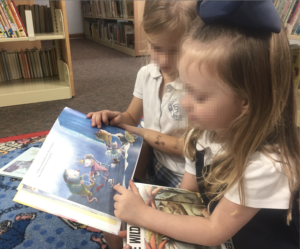** Contact us if you would like Literary Fusions to come to your campus with engaging, evidence-based, and practical professional development **
Once again Dan Santat‘s artwork attracted me to the cover. I was actually browsing Amazon when the cover popped up and I clicked it right away. The cover made me instantly laugh. There’s a warning label stating that, “No herbivores were injured, physically or emotionally, in the making of this product.” Definitely a “Jessica book” – it went in the cart.
Why I Finished It:
It is clever and unexpected! Picture two adults and one eleven-year-old reading this book in a Barnes and Noble, laughing and studying each layout … there was no way that I was not going to finish this book!
Three carnivores (the lion, shark, and wolf) are feeling mistreated by all the other animals. They form a support group to try and change their natural ways, to no avail. Finally, they give in and realize they are who they are and there is nothing wrong with that! Cue Stuart Smalley:
While this sums up the events of this book, there are so many unexpected moments and interactions with the characters that I refuse to talk about here. The writing is witty and engaging…no way will I ruin this book for you!
Who I Would Give It To:
Every elementary classroom and anyone who loves to read aloud to kids. This book has a natural voice and interactive quality that makes it a perfect read aloud. Of course, I feel science teachers should also have this book. This is a much more entertaining way to learn about food chains than any textbook!
Integration Ideas:
Reading Strategy: Point of View and Making Connections
I am forever challenging teachers to teach perspective. In terms of a global perspective, I think students should learn other perspectives for understanding and empathy. In school, students have to make inferences and think about characters who are different from them, to do this they must practice thinking about various perspectives.
This book makes perspectives hilarious! Has anyone really thought about how the lion feels? A shark? This book starts kids thinking about other perspectives. In this day and age, with so much bullying among kids, I would use this book to start talking about how we treat others. Pose questions to the students: How do you think others feel when they are being talked about behind their back? Should others change in order to fit in with everyone else?
I immediately thought of Jon Scieszka’s The True Story of The Three Little Pigs. In this story, the standard story of The Three Little Pigs is told from the wolf’s perspective. There are so many fairy tales out that do the same thing. Have students, in groups, read one of these other stories and discuss the different perspectives.
Writing Ideas: Writing from Another Perspective
Have student groups decide on a popular fairy tale. Have the group identify the villain and the hero. After students recap the events of the story as they are traditionally recounted, have them discuss the perspective of the villain. How were they misunderstood? Then send the groups back to write their own story from the point of view of the villain.
For older students have them take a news article or a passage from a history text. Ask the student groups to discuss the point of view of the article and the author’s bias. Then have the students discuss other perspectives. Send students back to rewrite the article from a different perspective.
Writing Conventions: Ellipses and Quotation Marks
Aaron Reynolds uses a variety of dialogue in this picture book. Each day, take one sentence with quotation marks from the text and have students discuss what they notice. Have a conversation with students about where the comma is in relation to the quotation marks, where the ending punctuation is in relation to the quotation marks, where the quotes go, etc. Ask students to add dialogue to their own papers.
I don’t believe ellipses are in anyone’s standards, but your skilled writers will love using them. I would pull out the sentences from the text with ellipses and work with a small group of gifted writers. Ask them why the author is using ellipses and what is the effect on the reader. Have students read the sentences with emotion. Then help students add ellipses to their own writing.

Reading Strategies: Making Inferences and Character Traits
There are many places in this book where the pictures and text provide clues as to something that is happening in the story, but it never says it explicitly. Have students study the pictures and the text to decide what is happening in the story. Some are more obvious than others, but all are amusing! I would share specific places in the book, but I REALLY don’t want to ruin this read for you. Trust me, you’ll find it. (Or contact me and I will share)
The three main carnivores here are going through a bit of a personality crisis in this story. Have students discuss their character traits and feelings. Every page could be used for this! Here’s page 1:
The lion tries to ignore it wehn the gazelles whisper behind his bck. He pretends not to see the zebras looking down their noses at him. The wildebeests call him “bad kitty” just because he’s eaten half the neighborhood.
It hurts. It really does.
The words might seem perfect, but the picture adds depth! Have students discuss the typical traits of a lion and then share his feelings. How are they different? Lions might be brave, ferocious, strong animals, but right now he’s feeling depressed, deflated, and lonely. The amount of time you spend here is up to you, but letting students know that no matter of the character trait that same character will go through a whole host of feelings in a lifetime! The other focus for us as we teach character traits and feelings is that students explain the text evidence for how they say the character is feeling and explain the why.
There are quite a few places in this book where teachers can bring up life science concepts. Students can spend time discussing how animal traits dictate their diet and nature. Here are some books to make text-to-text connections:
This text will also open up conversations about food chains, predators, prey, and habitats!
How would you use Carnivores in your classroom?









Leave a Reply